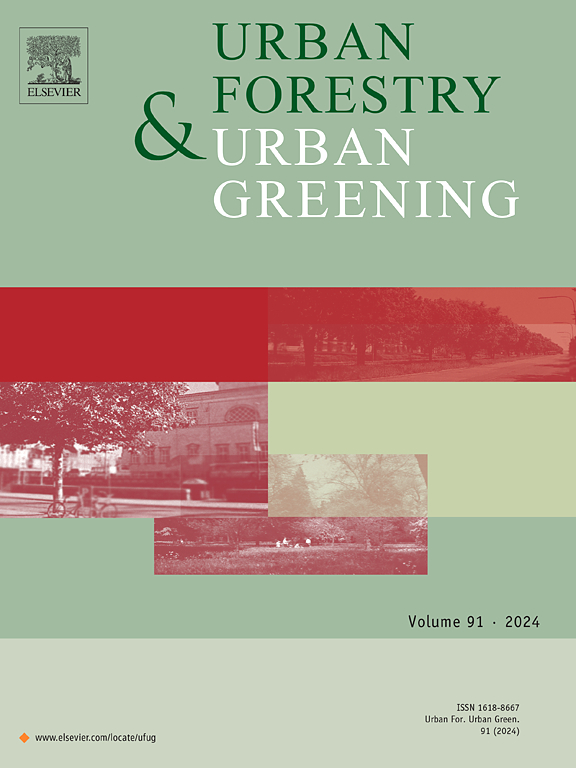Interactive mapping of allergenic urban street trees in Australia
IF 6
2区 环境科学与生态学
Q1 ENVIRONMENTAL STUDIES
引用次数: 0
Abstract
Tree pollen can be a persistent allergen for sensitised individuals, causing allergic rhinitis and asthmatic symptoms. Increased urbanisation results in larger populations living in cities and relying on urban greenspaces for recreation and associated ecosystem services, where the street landscapes are determined by urban planners. Urban forest strategies broadly divide planting choices based on biological functionality, climate resilience and environmental benefits but increasingly the associated physical and mental health impacts of urban vegetation are being considered. Here, we studied pollen allergenicity in four Australian cities by incorporating measures of allergenicity in existing street tree asset databases and visualising these using a simple and flexible mapping tool, the mapview package in R. Olea europaea (olive) and Betula nigra (river birch) were the most abundant trees with the greatest allergenic potential across all four cities, and hotspots of tree clusters with high allergenic potential could be easily visualised. The lack of allergenicity data for native Australian trees was also apparent, despite these comprising a large proportion of the urban street scapes. Incorporating allergenicity in mapview provides an interactive tool which is more easily interpretable for the public and urban landscape stakeholders than existing GIS based risk mapping techniques, and which can support decision making in future planting to avoid high concentrations of allergenic trees.
澳大利亚致敏性城市行道树的交互式制图
树花粉对敏感个体来说是一种持续的过敏原,可引起过敏性鼻炎和哮喘症状。城市化程度的提高导致更多的人口居住在城市,并依赖城市绿地来娱乐和相关的生态系统服务,其中的街道景观由城市规划者决定。城市森林战略根据生物功能、气候适应能力和环境效益对种植选择进行了广泛划分,但越来越多地考虑到城市植被对身心健康的相关影响。本研究通过结合现有街道树木资产数据库中的致敏性指标,并使用简单灵活的制图工具对四个澳大利亚城市的花粉致敏性进行了研究,结果表明,R. Olea europaea(橄榄)和Betula nigra(河桦树)的mapview包是四个城市中最丰富、致敏潜力最大的树木,具有高致敏潜力的树簇热点可以很容易地可视化。尽管澳大利亚本土树木在城市街道景观中占很大比例,但显然缺乏澳大利亚本土树木的致敏性数据。与现有的基于GIS的风险制图技术相比,将过敏原性纳入mapview提供了一个交互式工具,对公众和城市景观利益相关者来说,它更容易解释,并且可以支持未来种植决策,以避免高浓度的过敏原树。
本文章由计算机程序翻译,如有差异,请以英文原文为准。
求助全文
约1分钟内获得全文
求助全文
来源期刊

Urban Forestry & Urban Greening
FORESTRY-
CiteScore
11.70
自引率
12.50%
发文量
289
审稿时长
70 days
期刊介绍:
Urban Forestry and Urban Greening is a refereed, international journal aimed at presenting high-quality research with urban and peri-urban woody and non-woody vegetation and its use, planning, design, establishment and management as its main topics. Urban Forestry and Urban Greening concentrates on all tree-dominated (as joint together in the urban forest) as well as other green resources in and around urban areas, such as woodlands, public and private urban parks and gardens, urban nature areas, street tree and square plantations, botanical gardens and cemeteries.
The journal welcomes basic and applied research papers, as well as review papers and short communications. Contributions should focus on one or more of the following aspects:
-Form and functions of urban forests and other vegetation, including aspects of urban ecology.
-Policy-making, planning and design related to urban forests and other vegetation.
-Selection and establishment of tree resources and other vegetation for urban environments.
-Management of urban forests and other vegetation.
Original contributions of a high academic standard are invited from a wide range of disciplines and fields, including forestry, biology, horticulture, arboriculture, landscape ecology, pathology, soil science, hydrology, landscape architecture, landscape planning, urban planning and design, economics, sociology, environmental psychology, public health, and education.
 求助内容:
求助内容: 应助结果提醒方式:
应助结果提醒方式:


